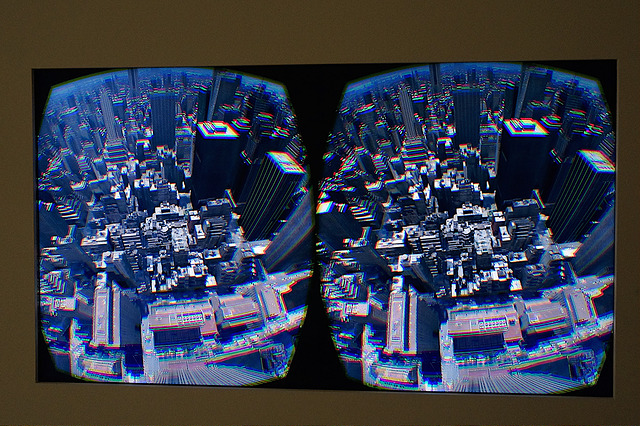Last week I attended the annual Association of Science and Technology Centers conference. One of my favourite parts of the conference is the exhibit hall. That’s where vendors and science centres from all over the world present devices, services and travelling exhibits they hope will entice attendees.
This year, two products really stuck out for me. One was a virtual reality (VR) experience, the other augmented the real world.
The VR experience was Birdly. To enter the world of Birdly, I lay face-down on a cross-shaped padded table with articulated wings. A fan at the front of the contraption was blowing a stream of air into my face. With my arms spread wide along the length of the wings, I could tilt and rotate them. My wrists could even turn the wing tips up and down like ailerons.
The demonstrator strapped me into a VR headset and placed stereo headphones over my ears. Then he fired up the unit’s software. I was suddenly hundreds of feet above an ersatz New York City. As I tilted and pivoted the wings, I glided, dove, climbed and banked like a bird in flight. The faster I flapped my arms, the more distance I covered. When I dove, the fan I could no longer see blasted more air into my face. My ears were filled with the sound of rushing wind. I could look up, down and all around. The sky, skyline and buildings below me appeared in perspective and all around me. I flew between two skyscrapers, strafed a street, then arched upward, aiming for the Empire State building. I felt like a pigeon in search of a perch.
The experience was remarkable. The Birdly booth had lineups all during the expo. It was a great example of how captivating and convincing a VR experience can be.
A few rows away, the Topobox presented a very different, but no less impressive example of, this time, augmented reality. The Topobox is really a magic sandbox. That sandbox was on a tabletop. It was ordinary white sand, like at a Florida beach. But above it was a projector, a computer and a distance sensor. When the projector turned on, the white sand was replaced with a multi-coloured topographic map complete with contour lines. Different colours denoted depth, from dark brown valleys to snowy white mountain tops.
I reshaped the sand, piling it up in one spot, digging a winding riverbed through the previously flat mesa. Almost instantly the contour lines and colours shifted, matching exactly the new topography I created. Next I held my hand about eight inches above the surface of the sand. My hand had become a virtual cloud. Rainwater spread across the landscape and began flowing along the winding riverbed I’d created. It even climbed the outer bank of the river, the way fast-moving river water does. The fluid dynamics were perfect.
Watching the shifting landscape and flowing river, it was difficult to imagine it was just white sand. It really appeared to be a miniature world, being terraformed in real time by giant hands.
Like Birdly, the illusion was convincing. In both instances I was above a realistic world. In one case, I was flying through it like a superhero. In the other, I was altering it like a lesser god.
In his most recent book, American historian David McCullough says the Wright brothers were captivated by the idea of humans flying when, as small boys, their father gave them a toy helicopter he brought home from France.
Anyone watching children on a beach know how a plastic shovel and a bucket of lake water can turn sand into a castle and a kingdom. These are just more complex toys with the same intention. Or, to think about it another way, the devices were imagination prosthetics for adults.
When both demonstrations stopped, when I was just looking a pile of white sand, or realizing I was really just strapped belly down on a bendy massage table with a crowd watching me gyrate, it took a few moments to adjust my perspective. And in those moments the world seemed intensely, sadly ordinary. Gravity engaged again. The sand was colourless. There was no wind, no water.
That’s the difference between adults and children. I felt the weight of stepping from the realm of magic into the real world. For children with toy helicopters and plastic shovels, there’s room enough in reality for both. Maybe experiences like these will help us relearn that lesson.
Listen to an audio version of this column, read by the author.
Wayne MacPhail has been a print and online journalist for 25 years, and is a long-time writer for rabble.ca on technology and the Internet.
Image: Kristina D.C. Hoeppner/flickr
Like this article? rabble is reader-supported journalism. Chip in to keep stories like these coming.



